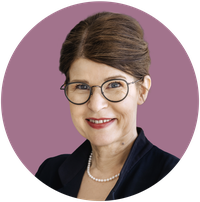How EBRAINS helps people

“The EBRAINS platform ‘The Virtual Brain’ is a great success for clinical application. In initial applications, it is already helping to find the best, personally tailored medical measures for patients. Our BigBrain brain model plays an important role in this process. I am also currently developing a 3D spinal cord atlas that will show the fine structure of neurons and their connections, and will be available through EBRAINS. One goal is to provide better treatment for patients with acute pain. I’m expecting to see sensational applications for a variety of diseases.”
Prof. Katrin Amunts (61) | Director at INM-1 and joint CEO of EBRAINS 2.0

“The colourful images from our 3D polarized light imaging (PLI) method, which we are using to try and map the roughly three million kilometres of nerve fibres in the brain, are not only of interest for us researchers. Once we know enough about how nerve fibres in the brains of healthy people connect to form neuronal networks, we will make this information available to colleagues in clinics via the EBRAINS atlas. This will allow them to draw conclusions for patients with brain diseases in future, as it is precisely these nerve fibres that are damaged in some cases.”
Prof. Markus Axer (50) | Physicist at INM-1 and developer of the 3D PLI microscopy method

“In the EU project EBRAINS 2.0, I work together with international colleagues on models of individual brain areas and the entire brain, which should help to improve individual therapies in future – for those with epilepsy, for example. Enhanced with personal clinical data from patients, such models enable more precise predictions. Surgeons might therefore be able to recognize in advance of an operation just how much brain tissue should be removed and from where in order to successfully eliminate epileptic symptoms. My research helps to further improve the models. To do so, I use valuable EBRAINS data and the EBRAINS tool NEST, which I co-developed and which can be used to simulate large-scale neural networks.”
Prof. Sacha van Albada (43) | Neuroscientist at IAS-6

“Our brains are just as different as we humans look and behave. We are therefore contributing data from our 1,000 brains study to the connections between the brain regions in the EBRAINS brain atlas. In future, doctors will also be able to use our extensive research findings about living brains and their diversity via EBRAINS. This might be, for example, when they have to decide whether a conspicuously small brain area of an older patient is still “normal” or whether it deviates from the usual distribution of the population based on the clinical MRI data.”
Prof. Svenja Caspers (41) | Head of the “Connectivity” working group at INM-1
Originally published in the employee magazine "intern" of Forschungszentrum Jülich.
Author: Hanno Schiffer
Contact Persons
Prof. Dr. med. Dr. h.c. Katrin Amunts
Director of the INM-1 and Working Group Leader "Architecture and Brain Function"
- Institute of Neurosciences and Medicine (INM)
- Structural and Functional Organisation of the Brain (INM-1)
Building 15.9 /
Room 3022
Room 3022
+49 2461/61-4300
E-Mail
Prof. Dr. Markus Axer
Working Group Leader "Fiber Architecture" Deputy Head of INM-1
- Institute of Neurosciences and Medicine (INM)
- Structural and Functional Organisation of the Brain (INM-1)
Building 15.9 /
Room 3029
Room 3029
+49 2461/61-6314
E-Mail
Prof. Dr. Sacha van Albada
Group Leader - Theoretical Neuroanatomy
- Institute for Advanced Simulation (IAS)
- Institute for Advanced Simulation (IAS-6), Computational and Systems Neuroscience
Building 15.22 /
Room 2002
Room 2002
+49 2461/61-96808
E-Mail
Prof. Dr. med. Dr. rer. pol. Svenja Caspers
Working Group Leader "Connectivity"
- Institute of Neurosciences and Medicine (INM)
- Structural and Functional Organisation of the Brain (INM-1)
Building 15.9 /
Room 4015
Room 4015
+49 2461/61-1742
E-Mail
Media Contacts
Erhard Zeiss
Wissenschaftlicher Kommunikationsreferent
- Institute of Neurosciences and Medicine (INM)
- Structural and Functional Organisation of the Brain (INM-1)
Building 15.9 /
Room 3033
Room 3033
+49 2461/61-1841
E-Mail
Related COntent
Last Modified: 19.07.2024






